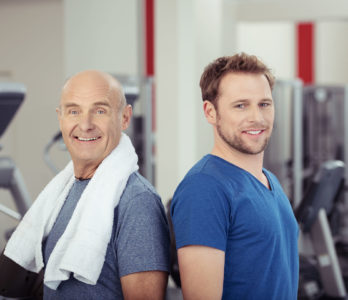 Should you fuel up before hitting the gym, or is it best to burn calories on an empty stomach? That’s the question researchers at the University of Bath in England sought to answer with their latest study.
Should you fuel up before hitting the gym, or is it best to burn calories on an empty stomach? That’s the question researchers at the University of Bath in England sought to answer with their latest study.
For their research, the team decided to look at the fat burning capabilities of exercise based on when the participant last ate. They were wondering if when a person ate influenced how much muscle fat was burned during activity, because muscle fat can be a key contributor to the eventual onset of insulin resistance and diabetes. For their study, the team divided 30 overweight men into three groups.
- A control group that lived their normal lives.
- A group that consumed a vanilla-flavored shake two hours before cycling exercise.
- A group that consumed a placebo shake two hours before cycling exercise.
Participants wore monitors and masks that tracked a number of different factors, including their heart rate and the amount of fat and sugar they burned. After exercise, the participants drank the shake they had not yet consumed (placebo for the vanilla shake group, and a vanilla shake for those who consumed a placebo before exercise).
The study lasted for six weeks, and researchers drew some interesting conclusions after looking at the data. As expected, the control group’s insulin sensitivity remained unchanged, while the men in both exercise groups improved their fitness and narrowed their waistlines, although few actually lost weight. Notably, participants who pedaled on an empty stomach burned about twice as much fat during each ride as the men who consumed their shake prior to exercise. All riders burned about the same number of calories while pedaling, but more of those calories came from fat when the men did not eat first. Riders that consumed the shake afterwards also had greater improvements in insulin sensitivity and had developed higher levels of certain proteins in their muscles that influence how well muscle cells respond to insulin and use blood sugar than the other groups.
“You can probably get more out of your workout without increasing its intensity or duration by exercising before breakfast,” said Javier Gonzalez, a professor of physiology and nutrition at the University of Bath, who oversaw the study.
So if you’re wondering when the best time to exercise is, it might be first thing in the morning after you wake up. That being said, any exercise is better than no exercise, so just get it in when it works for you!
 As someone who has suffered from chronic back pain for more than a decade, I know just how hard it can be to manage a chronic condition on a daily basis. You have good days where you feel like you can conquer the world, and you have bad days where you don’t even want to get out of bed. No matter what kind of day you’re having, it’s important that you push through any discomfort and find time to
As someone who has suffered from chronic back pain for more than a decade, I know just how hard it can be to manage a chronic condition on a daily basis. You have good days where you feel like you can conquer the world, and you have bad days where you don’t even want to get out of bed. No matter what kind of day you’re having, it’s important that you push through any discomfort and find time to  Adding an exercise to a busy person’s life is sometimes difficult. Many people claim that their daily activities give them enough exercise to stay healthy, and in some cases this may be true. Physicians are beginning to recognize that what we do as part of our regular routines may count as exercise. For meeting the goal of aerobic conditioning, the movement we do routinely is helpful.
Adding an exercise to a busy person’s life is sometimes difficult. Many people claim that their daily activities give them enough exercise to stay healthy, and in some cases this may be true. Physicians are beginning to recognize that what we do as part of our regular routines may count as exercise. For meeting the goal of aerobic conditioning, the movement we do routinely is helpful. New federal health guidelines want Americans to move more and get kids active, and this advice can also help to prevent and treat chronic pain. The three main talking points from the new guidelines, which are the first update to government physical activity guidelines in a decade, suggest that we need to move more, sit less and get kids active at a younger age. We take a closer look at all three of those talking points below.
New federal health guidelines want Americans to move more and get kids active, and this advice can also help to prevent and treat chronic pain. The three main talking points from the new guidelines, which are the first update to government physical activity guidelines in a decade, suggest that we need to move more, sit less and get kids active at a younger age. We take a closer look at all three of those talking points below. New research published in the Journal of Applied Physiology revealed that regular exercise can have your muscles acting as if you are decades younger than your actual age.
New research published in the Journal of Applied Physiology revealed that regular exercise can have your muscles acting as if you are decades younger than your actual age.